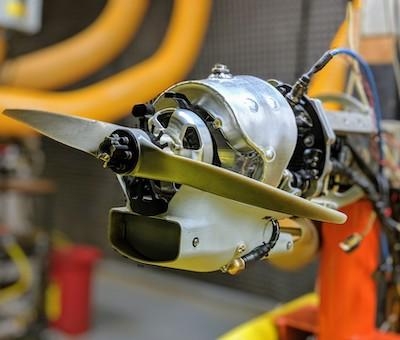Marks The Maturity Of The Small UAV Engine
The Northwest UAV NW-44 Heavy-Fuel Engine has reached the noteworthy milestone of logging over 21,000 operational hours. With an innovative design that focuses on maintainability, Northwest UAV’s NW-44 UAV Engine has developed a reputation for being the UAV industry’s reliable, cost effective propulsion solution.

Purpose-built for small unmanned aircraft systems (UAS) that require high reliability and easy maintainability, the NW-44 Engine is a lightweight, multi-fuel UAV engine. The NW-44 is a complete turn-key engine system designed to be a COTS solution for Tier II UAVs (40-75 lbs). Its innovative design virtually eliminates development costs, saving customers millions of dollars and several years stuck in the engineering development cycle. The milestone of 21,000 operational hours clearly speaks to the NW-44 Engine’s reliability, and in a less apparent way, its maintainability.
“Traditionally, engines for the Tier II UAV weight class are built to be throw-away engines,” said Jeff Ratcliffe, Chief Technical Officer of NWUAV. “That means they are not likely designed and built for 10-15-hour days at 45c (like the NW-44 Engine), rather they’re built for a few hours at the local airfield – on a nice day. While we understand why OEM’s initially use low-cost foreign-made engines from the hobby market – it can be a risky and potentially more expensive undertaking for the needs of professional unmanned systems today.”
“As the industry matures, COMPLETE traceability has become as critical to the engines as the parts themselves,” Ratcliffe continued. “Sophisticated customers will expect to know every aspect – who, what, where and how – of every component of the engines, as well as what it experienced prior to delivery. Simply put, untraceable components make the lifespan and containment of faulty components unpredictable and unmanageable. That is why the NW-44 is American Made, we control the quality and traceability of our parts. Relying on China, Taiwan or Korea in your supply chain is not a sustainable strategy for today’s customers.”
While the milestone of 21,000 operational hours clearly speaks to the maturity of the engine, NWUAV consistently looks for ways to continue to improve the engine and reduce maintenance requirements, with the end goal to be as bulletproof as possible in theater. “After 21,000 hours it’s pretty apparent what can and will go wrong. Not just on the engine system itself, but also with how the engine is being operated and maintained in very harsh environments with limited resources. This extensive insight can’t be duplicated in a test cell,” said Chris Harris, president and Owner of Northwest UAV.
As a result of the feedback NWUAV receives from field maintainers and operators, the company has undertaken an effort to update the engine’s muffler and generator, which will substantially reduce onsite maintenance and downtime. “The goal is to reduce the touch-time on the engine to only require scheduled spark plug changes, and the muffler update is part of that effort.” says Harris. “After each flight, engine operational data is downloaded on location and then analyzed and approved by a NWUAV specialist prior to the next flight. The ability for operators to be in immediate, direct contact with our experts and provide us with this data and direct feedback is a welcome, critical loop in support of our customers’ successful operations and our internal efforts for continuous improvement.”
Additional advancements currently in the works for the NW-44 include an Artificial Intelligence (Ai) module that can predict pending failures and required maintenance, carbon build-up resistant piston rings (Not Keystone), an altitude compensating carburetor and a lighter weight variant of the Multi-Fuel NW-44.
Though NWUAV was one of the first companies to successfully break from tradition and establish higher expectations for Tier II UAV propulsion systems, they continue to innovate and further advance expectations for Tier II systems, and with their NW-88 Engine, Tier III applications.
(Image provided with NWUAV news release)
 ANN's Daily Aero-Term (05.09.24): Hold Procedure
ANN's Daily Aero-Term (05.09.24): Hold Procedure ANN's Daily Aero-Term (05.06.24): Altitude Readout
ANN's Daily Aero-Term (05.06.24): Altitude Readout ANN's Daily Aero-Linx (05.06.24)
ANN's Daily Aero-Linx (05.06.24) Airborne-NextGen 05.07.24: AI-Piloted F-16, AgEagle, 1st 2 WorldView Sats
Airborne-NextGen 05.07.24: AI-Piloted F-16, AgEagle, 1st 2 WorldView Sats Aero-News: Quote of the Day (05.07.24)
Aero-News: Quote of the Day (05.07.24)



